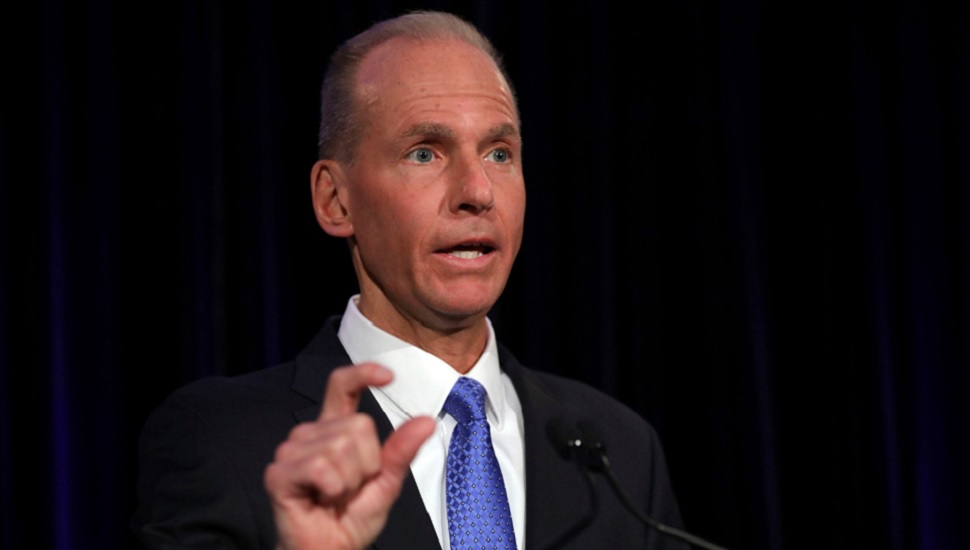Boeing’s chief executive is looking beyond the 737 Max crisis, saying today’s challenges will leave Boeing with a healthier supply chain and better prepared to capitalise on still-surging demand for new jetliners.
Dennis Muilenburg says Boeing still intends to decide this year whether to offer its proposed “new mid-market airplane” (NMA) for sale, though he does not say when that decision might come.
A decision whether to officially launch the NMA would then come in 2020, he tells investors on 29 May.
“Our overall broad timeline of that programme has not changed. We still see it as a 2025 entry-into-service type of airplane”, Muilenburg says of the NMA, an aircraft that would carry 200-270 passengers and have 4,000-5,000nm range.
“We are continuing to work through our business case analysis and continuing along a path of a two-step decision process,” he adds. Muilenburg, who stressed the 737 Max remains Boeing’s top priority, made his comments during a conference hosted by the research arm of AllianceBernstein.

Boeing chief executive Dennis Muilenburg speaks in Chicago on 29 April following Boeing’s annual meeting with shareholders
John Gress/AP/REX/Shutterstock
He also says the 777X programme remains on schedule, but concedes lessons learned from inquiries spurred by two 737 Max crashes could influence certification of that programme and others.
The US Congress and US Department of Transportation have launched reviews of US certification aircraft processes, and Boeing’s board established a committee to review its design and development work.
“It’s possible we could see something that could alter the content of the test programme, or how we go about certification,” Muilenburg says of the 777X
Still, he expects the 777X’s first flight will occur this year, followed by first delivery next. Two flight-test 777X are undergoing ground-based integration testing, two others are in final assembly, and testing continues on a static-test 777X airframe, he says. GE Aviation also continues testing the 777X’s GE9X turbofan.
Muilenburg, who spoke as the 737 Max grounding enters week 12, says Boeing continues making “clear and steady progress” toward getting the aircraft back in the skies.
The company finished testing an update to the manoeuvring characteristics augmentation system (MCAS) and is “in the process of applying for final certification”, Muilenburg says. “We are finishing a dialogue with the FAA, working through a series of questions and answers with them. Once that’s complete, we will schedule the certification flight.”
In the last two weeks, Boeing held 737 Max-related meetings with customers in Dubai, Europe, Miami, Moscow, Singapore, Shanghai and Tokyo, he says.
While again offering condolences to crash victims, Muilenburg’s 29 May comments took a positive tone.
“We see this as a defining moment for the Boeing Company. I am confident [that] on the back side of this we are going to come out even stronger,” Muilenburg says. “It has only reinforced, reinvigorated everything we are doing in driving quality and safety.”
The grounding has enabled Boeing to shore up a supply chain that had strained under aggressive 737 Max production plans.
“We have used this window, over the last couple of months, to make significant improvements,” Muilenburg says, calling out struggles endured by fuselage supplier Spirit AeroSystems and engine maker CFM International.
Though Boeing cut 737 production from 52 to 42 aircraft monthly following the grounding, CFM and Spirit have maintained the 52-aircraft-monthly engine supply rate.
“They have made a lot of progress… They are recovering to our production schedule,” Muilenburg says.
More broadly, he says demand for Boeing aircraft remains strong, with airlines estimated to need some 43,000 new aircraft within 20 years.
“We see a very solid aerospace market,” Muilenburg says. “We see another significant widebody replacement wave coming sometime in the next decade. The 787 and 777X are both well positioned.”
Source: Cirium Dashboard



















